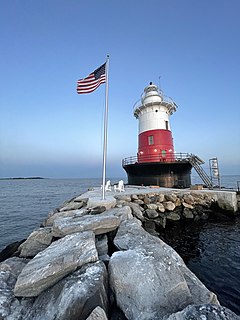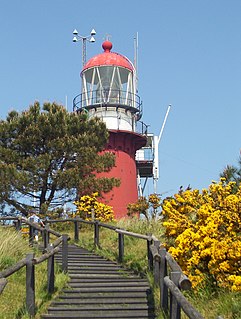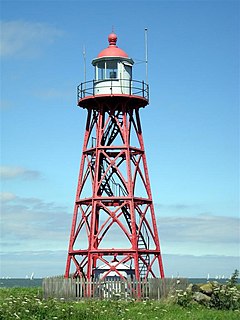
The Hague is a city and municipality of the Netherlands, situated on the west coast facing the North Sea. The Hague is the country's administrative centre and its seat of government, and while the official capital of the Netherlands is Amsterdam, The Hague has been described as the country's de facto capital. The Hague is also the capital of the province of South Holland, and the city hosts both the International Court of Justice and the International Criminal Court.

Scheveningen[ˈsxeːvənɪŋə(n)](listen) is one of the eight districts of The Hague, Netherlands, as well as a subdistrict (wijk) of that city. Scheveningen is a modern seaside resort with a long, sandy beach, an esplanade, a pier, and a lighthouse. The beach is popular for water sports such as windsurfing and kiteboarding.

Whiteford Point Lighthouse is located off the coast at Whiteford Point near Whiteford Sands, on the Gower Peninsula, south Wales.

Greens Ledge Lighthouse is a historic offshore lighthouse in the western Long Island Sound near Norwalk, Connecticut and Darien, Connecticut. It is one of 33 sparkplug lighthouses still in existence in the United States and remains an active aid to navigation. It sits in ten feet of water on the west end of Greens Ledge, a shallow underwater reef that runs a mile west of Sheffield Island and is roughly a mile south of the entrance to Five Mile River at Rowayton. Completed in 1902 by the Philadelphia Construction Company, the cast-iron structure is approximately 90 feet tall including roughly 15 feet of the submerged caisson. In 1933, more than 30,000 tons of rocks from the excavation of Radio City Music Hall were added to the riprap foundation. The light was added to the National Register of Historic Places as Greens Ledge Lighthouse on May 29, 1990.

Den Haag Laan van NOI railway station is a railway station in the Netherlands, on the border between The Hague and the town of Voorburg. It is served by the Nederlandse Spoorwegen and by the RandstadRail light-rail network. The station is named after the road on which it is located, Laan van Nieuw Oost-Indië, which literally translates as New East Indies Avenue, but probably refers to a former inn called Nieuw Oosteinde.

De Zwaluw is a smock mill in Hoogeveen, Drenthe, the Netherlands which is working commercially. It is the third mill to stand on this site as two previous mills both burnt down. It was built in 1834 and is listed as a Rijksmonument, No. 22254.

Lange Jaap, also known as Kijkduin Light or Den Helder Light, is an active lighthouse near Fort Kijkduin in Huisduinen, Netherlands. At a height of 63.5 metres (208.2 ft) it is one of the tallest "traditional lighthouses" in the world. For almost a century, from 1878 to 1974, it was the tallest lighthouse in the Netherlands, until the construction of the Maasvlakte Light. According to The Lighthouse Directory it is the tallest non-skeletal cast iron lighthouse in the world.

The Ameland Lighthouse, commonly known as Bornrif, is a lighthouse on the Dutch island Ameland, one of the Frisian Islands, on the edge of the North Sea. It was built in 1880 by order of William III of the Netherlands. It was designed by Dutch lighthouse architect Quirinus Harder and built by the foundry Nering Bögel in Deventer. The individual segments were shipped to Ameland and welded together on-site.

Vuurduin is a lighthouse on the Dutch island Vlieland. The tower is the top part of the former front light of the leading lights in IJmuiden, designed by Quirinus Harder.

The Eierland Lighthouse is a lighthouse on the northernmost tip of the Dutch island of Texel. It is named for the former island Eierland.

The Stavoren Lighthouse is a lighthouse near Stavoren on the IJsselmeer, in the Netherlands. On two nearby piers are a red and a green light beacon for the Stavoren harbor. All were built in 1885 and are Rijksmonuments since 1999. The lighthouse was restored in 2001.

Vuurtoreneiland is a small island in the IJmeer, Netherlands, just off the coast of Durgerdam. The island's main function is as a base for a lighthouse; a military fort on the island was abandoned in the 1930s.

The hoge vuurtoren van IJmuiden is a round, cast-iron lighthouse in IJmuiden, Netherlands, designed by Quirinus Harder. It was built in 1878 by D.A. Schretlen & Co, a company in Leiden.

The Lage vuurtoren van IJmuiden is a round, cast-iron lighthouse in IJmuiden, Netherlands, designed by Quirinus Harder. It was built in 1878 by D.A. Schretlen & Co, a company in Leiden and activated the following year. In 1909, the top three sections were moved to Vlieland where they serve as a separate lighthouse. In 1966 the lighthouse was moved slightly.
Quirinus Johan Harder was a Dutch architect best known for having designed a large number of lighthouses. He worked as a structural engineer for the Loodswezen, the Dutch organization overseeing all maritime pilots. Harder's lighthouses were made of cast iron, a new material at the time, which allowed for segmented fabrication and construction.

Nieuwe Sluis is a Dutch lighthouse in the Nieuwesluis community, a few kilometres west of Breskens, Zeeland, and the southernmost in the country.

The Westerlichttoren or West Schouwen is a lighthouse in Haamstede, Netherlands. Designed by L. Valk, it was built in 1837. At 47 m above ground and a light stand at 58 m above sea level it is one of the tallest lighthouses in the Netherlands.

The Low Light of the Hook of Holland is a lighthouse that once stood at the Hook of Holland, but has since been dismantled and reassembled near the Rotterdam maritime museum.
The Vischpoort or Vispoort is a late-14th-century city gate and former lighthouse in Harderwijk, Netherlands. The gate, which is located on the historical seaside of the Zuiderzee, is the only one of five gates in the city walls that remains. Between 1851 and 1947 the Vischpoort served as a lighthouse. The Vischpoort is listed as a national heritage site.

The Vuurbaak van Katwijk aan Zee is a Dutch lighthouse in Katwijk aan Zee, in South Holland, on the North Sea. It is the second oldest lighthouse in the country; only the Brandaris (1594) is older. The lighthouse was essentially just a 12-metre-tall (39 ft) tower on top of which a fire was lit whenever Katwijker fishers were out at sea. The fire was replaced with an oil lamp in the mid-19th century; by the early 1900s there were no fishing vessels from Katwijk and the lighthouse became inactive.




















